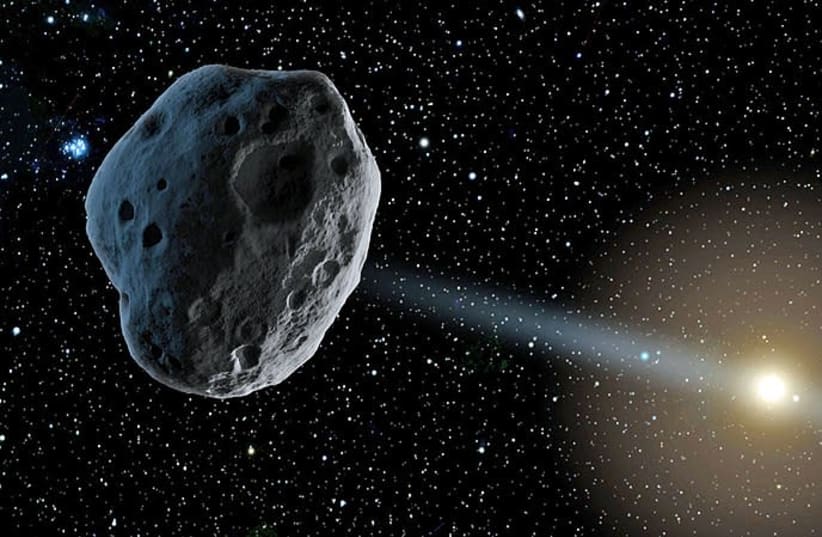A newly discovered asteroid stands out as one of the fastest objects in the solar system, orbiting around the sun far faster than any other known asteroid.
Dubbed 2021 PH27, the asteroid is about a kilometer in size and orbits around the Sun, doing a full lap every 113 days. This is far faster than any other object in the solar system, save for Mercury, the first planet from the Sun, which completes a lap in just 88 days.
But while Mercury may be faster, this asteroid can get closer.
2021 PH27 has an unstable orbit crossing those of Mercury and Venus in its orbit around the Sun. Most likely, it originated from the asteroid belt between Jupiter and Mars, dislodging and eventually getting caught in the Sun's orbit. But on occasion, this unstable orbit brings it even closer to the Sun than Mercury, as close as 12.4 million miles (20 million km.). For context, Mercury, at its closest, is only 29 m. miles (47 million km.) away.
And getting this close means the Sun's heat hits the asteroid hard.
“2021 PH27 gets so close to the Sun that its surface temperature gets to around 900 degrees Fahrenheit at closest approach, hot enough to melt lead,” Carnegie Institution for Science's Scott Sheppard, who led the team discovering the asteroid, explained in a statement.
Because of the asteroid's unstable orbit, it won't stay that way forever. It is estimated that in a few million years or so, 2021 PH27 will eventually impact Mercury or Venus, or end up flying into the Sun.
But one question remains regarding this asteroid: Why have we only just discovered it now, if it's so close to the Sun?
THE ASTEROID was discovered by Sheppard and an international team of astronomers on August 13. To do this, they had to utilize the Dark Energy Camera on the Victor M. Blanco 4 meter Telescope at Chile's Cerro Tololo Inter-American Observatory and it had to be properly examined at twilight. This is because of how hard it is to find asteroids between the Sun and Earth, and how twilight is the ideal time to look for them.
This is true for all objects closer to the Sun than the Earth is, with Mercury and Venus always being most visible in the sky at twilight.
These objects tend to approach the Earth during the daytime, which means they can often be obscured by the Sun's glare.
“Because the object was already in the Sun’s glare and moving more toward it, it was imperative that we determine the object’s orbit before it was lost behind our central star,” explained Dave Tholen of the University of Hawaii, who was part of the study. “I surmised that for an asteroid this size to remain hidden for so long, it must have an orbit that keeps it so near to the Sun that it is difficult to detect from Earth’s position.”
Asteroids closer to the Sun than the Earth present a notable hole in most surveys of asteroids near the Earth because they are so difficult to detect. As a result, understanding them is of vital importance.
This is because these asteroids can still come into close proximity to the planet, and thus could possibly pose a potential impact risk in the future.
“One of the reasons why it is hard to achieve the goal of finding 100% of all Near-Earth objects (NEO) larger than a kilometer is because some have orbits that help ‘hide’ them from Earth-based observers,” Tholen explained. “Objects like this one – orbiting entirely interior to the Earth’s orbit – are difficult to find and track. There are likely more such objects that have yet to be discovered, and we need a better census of them to estimate what might be the threat of Earth impact.”
As of now, scientists don't think 2021 PH27 could ever pose a threat to the planet, but the same cannot be said with certainty for all asteroids.
An asteroid impact remains one of the most dangerous possible natural disasters that could occur, however unlikely. It is for this reason that astronomers around the world, including at NASA's Planetary Defense Coordination Office, work to monitor all nearby asteroids and calculate their trajectory to see if any of them pose a threat to the planet.
This is done through the use of special "asteroid hunter" telescopes, but some projects, like the Double Asteroid Redirection Test (DART) Mission launched by the PDCO and John Hopkins University, seek to find ways of defending against asteroids themselves.
